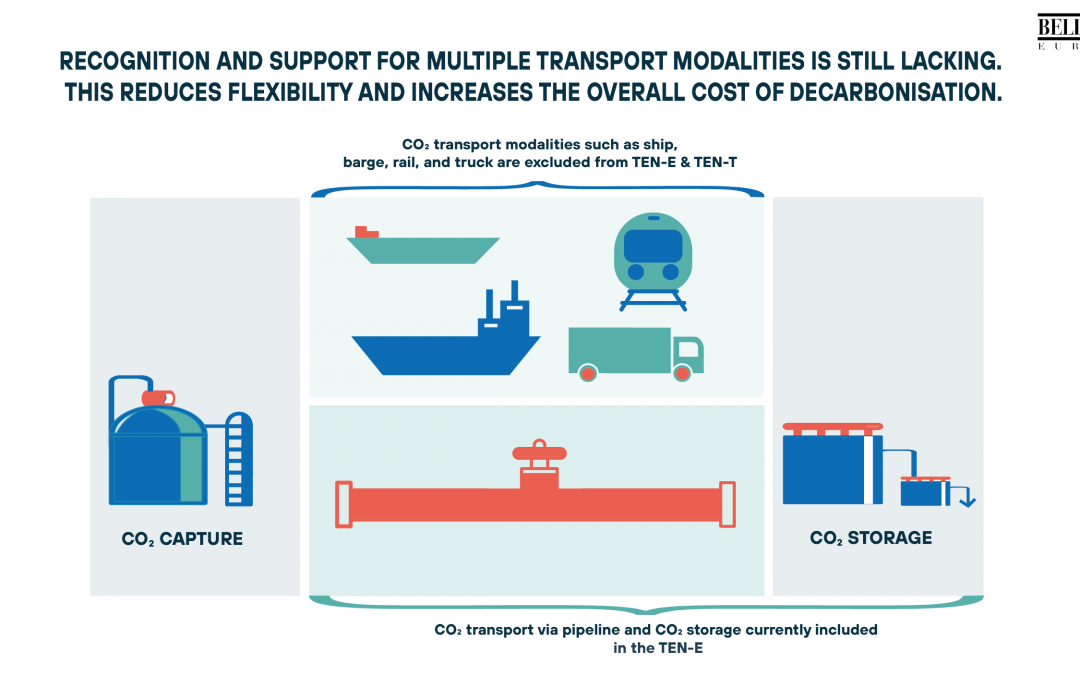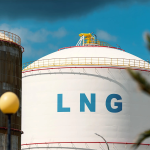The European Commission published its proposal for the ongoing revision of the Trans-European transport network (TEN-T) on the 16th of December 2021. The TEN-T proposal clearly identifies the need to take into account possible synergies with other networks, such as the TEN-E Regulation, in its Article 5 point (f). Unfortunately, the current proposal from the European Commission misses a great opportunity to do so by not including support for multiple modalities transporting CO2 to storage.
While it is still not certain where the ongoing revision of the TEN-E Regulation will land, the current proposal includes CO2 storage and transport via pipeline as eligible for Project of Common Interest (PCI) status. Eligibility for PCI status not only sends an important market signal, it can come with both administrative and financial support mechanisms depending on the scope.
Multiple transport modalities for CO2 such as ship, barge, truck and rail are not included as eligible for PCI status in the TEN-E. This sends a negative market signal which fails to reduce investor risks – a much-needed step to enable the private market and encourage first-movers.
Several planned projects for carbon capture and storage already rely on multiple modalities for part of their CO2’s transportation to storage. Such mobile modalities for transport are particularly important in the initial phase of market development, given the higher degree of flexibility associated with mobile assets as opposed to immobile pipelines. Multiple transport modalities are also key to enable equitable access across Europe – including for countries with no access to storage themselves.
Bellona Europa, together with Clean Air Task Force (CATF), has throughout 2021 led the campaign #TenETuesday, focusing on the need for recognition of CO2 storage and multiple transport modalities in the TEN-E Regulation. We now continue these efforts by launching our updated campaign #TenTTuesday – focusing specifically on ensuring recognition of multiple transport modalities in the TEN-T Regulation as it has not been included in the TEN-E. We cannot risk this vital infrastructure falling in between two chairs, and will therefore in the coming months seek to highlight challenges facing multiple transport modalities as part of a European CO2 network, as well as opportunities. The TEN-T is one such opportunity.
Not only will recognition under the TEN-T optimize possible synergies with other networks such as TEN-E as outlined in Article 5 (f), it will contribute both direct and indirectly to decarbonizing the transport sector. Carbon capture and storage play a vital role in the production of low-carbon hydrogen – and is key to kick-start a market for hydrogen-derived fuels such as ammonia for sector such as marine and shipping. Carbon capture and storage also enables industry to decarbonize at a quicker pace, reducing its reliance on renewables – freeing up low-carbon power for other applications including electrification in the transport sector.
Nearly all EU net-zero by 2050 scenarios rely on large-scale carbon capture, and storage. It is therefore important that the European Union contributes in every way possible to kick-start market development. Important steps in the right direction have been taken for CO2 storage in the TEN- E Regulation (pending final approval), as well as by recognition of multiple transport modalities’ role in both the proposed revision of the EU ETS and the EU Sustainable Finance Taxonomy. Not following through by including important recognition and support in the TEN-T Regulation for multiple transport modalities, in particular when it connects to the CO2 infrastructure category and PCIs projects already included in the TEN-E Regulation, is therefore a potential lost opportunity Europe simply cannot afford on the path to net-zero by 2050.
It is therefore our strong recommendation that the European Commission’s proposal for the TEN-T Regulation is amended to include the below, in particular as it relates to optimize for synergies with the TEN-E Regulation as set out in Article 5 (f) by:
• Reduce perceived investor risks in the private market by granting PCI status to multiple modalities transporting CO2 to storage
• Enable rapid market development by administrative, permit granting and public consultations support mechanisms granted to PCI projects
• Contribute to actual project deployment by funding support offered by CEF to PCIs
Source: Hellenic Shipping News





